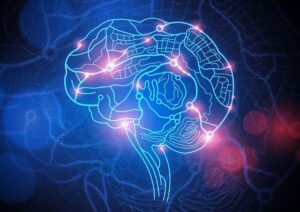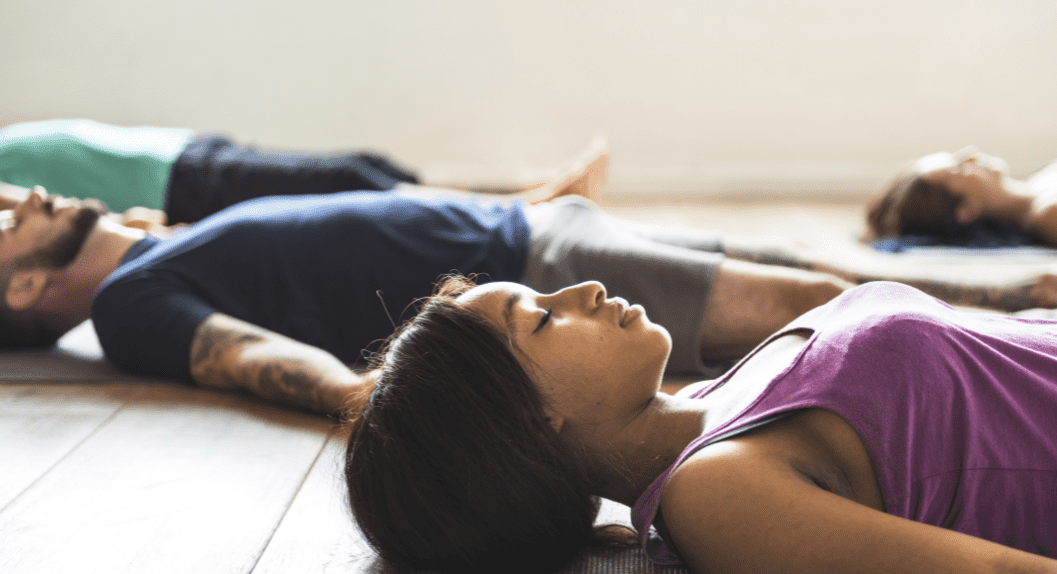An Interview with Joann Lutz
Can you imagine a future in which someone’s first introduction to Yoga is not in a gym or classroom, but in a therapist’s office? It may be a future that’s not too far off, thanks to Yoga instructors and qualified mental health professionals like Joann Lutz, who are dedicated to bringing the bridging the gap between Yoga and mental health. An experienced Yoga therapist, Integral Yoga teacher, and licensed independent clinical social worker, Joann spoke with us about the effects of Yoga on the nervous system, trauma-sensitive Yoga, and research that supports the use of Yoga in treating mental health conditions.

Scientists now know that trauma affects the base of the brain stem, where the autonomic nervous system (ANS) is located.
Yogaville: Trauma is a current topic of focus in the field of mental health. What’s the role of the nervous system in trauma and what effect does Yoga have on the nervous system?
Joann: Neuroscience is now able to see images of what happens in the brain as a result of trauma. Therefore, there is now a scientific basis for trauma therapy. Modern neuroscience shows that trauma activates the reptilian brain—the oldest part of the brain, evolutionarily speaking—located in the brain stem. This is where the autonomic nervous system is located, which controls automatic body processes. So, in addressing trauma, the field is beginning to shift from working primarily with thoughts and emotions, to working with the autonomic nervous system. In fact, research shows that when someone is traumatized, their cognitive functioning is impaired.
As it turns out, Yoga excels in helping to regulate the autonomic nervous system. It almost seems as if it were designed to regulate that system. In my work, I have looked for the correspondences between Yoga practice and the autonomic nervous system (ANS), and have found many.
Yogaville: Are all forms of Yoga trauma-sensitive?
Joann: As you know, there are many forms of Yoga. There are two aspects of Yoga in particular that help regulate the ANS; the first is connecting with bodily sensations. When someone can connect with their physical sensations from moment to moment, that awareness helps regulate the ANS. A meditative style of Yoga, which was designed to foster a stable, healthy body and train the mind to be present to its sensations, is a powerful ANS regulator.
The second practice that helps regulate the ANS is taking slow, deep breaths. Since Integral Yoga focuses on developing both of these skills, it is a particularly beneficial style of Yoga for addressing the effects of trauma.
There are also other components of trauma-sensitive Yoga; one aspect is the conscious effort to have the students feel safe in the room. The class should be held in a private space where people can’t look in the windows. The classroom space should be physically comfortable, with enough light, enough space between the mats, and a comfortable temperature. The instructor of a trauma-sensitive Yoga class should also let the students know where he or she is in the classroom at all times so as to not accidentally surprise anyone. It is also recommended that the instructor not touch any students in class, as it could be triggering. There should be a supportive, loving tone to the teacher’s voice. Some styles of Yoga are authoritarian, but trauma-sensitive Yoga should offer students as many choices as possible, without any commands. I think Integral Yoga is also strong in these aspects.

Yoga has been shown to have a positive effect on mental health conditions, including PTSD.
Yogaville: In 2014 you published a CEU course, “Bringing Yoga into Social World Practice.” Is research supporting the use of Yoga in mental health treatments?
Joann: Absolutely, yes. For instance, here’s just one example: one of the leaders in bringing Yoga into healthcare, Dr. Bessel van der Kolk, directed the Trauma Center in MA. While he served there, he was funded for a major study involving Yoga for women with PTSD that were resistant to other forms of treatment. He found they did very well with Yoga. There was a 33% decrease in symptoms of PTSD after 10 weeks. There was a 17% decrease for a group that worked solely with educating the mind. In that particular case, Yoga proved to be twice as effective as a traditional psychotherapy group intervention.
Conversely, Yoga can also have a negative impact on traumatized individuals if they go to a class that’s not trauma-sensitive. It is possible that it could more deeply traumatize them, creating feelings of unworthiness or ineffectiveness.
Yogaville: Could you speak about your course, Living with Your Nervous System, and how you instruct practices to regulate the nervous system?
Joann: I have developed a new method of ANS education that is fun as well as instructive, called Neurodrama, which I’ll be offering during the workshop, Living with Your Nervous System.
There’s are four main ANS responses, including fight, flight, freeze, and social engagement. In Neurodrama, the class is split into these 4 groups. As I narrate a hypothetical dangerous situation, participants will act out the various reactions of the nervous system. Then, I introduce different yogic interventions that help to bring nervous system back into balance. So the course is very much experiential, not just lecture-based.
Yogaville: You’re currently completing a book, Trauma Healing in the Yoga Zone. Could you tell us about it?
Joann: The book, based on Integral Yoga, is structured around the 8-limbed path of Raja Yoga, as described in the Yoga Sutras of Patanjali. There are chapters on Hatha Yoga, pranayama, pratyahara, etc. It is primarily designed for mental health professionals, Yoga therapists, Yoga teachers, and related professions, I combine the latest research with techniques from somatic psychotherapy and classical Yoga. It is currently scheduled to be published sometime in 2019.
Yogaville: What’s the nature of your current work in the field of mental health and Yoga?
Joann: I developed a training program for mental health and Yoga professionals which I teach all over the US. This training is about bringing Yoga right into the therapy session. The focus is on chair Yoga, breathing, and relaxation, and how they influence the underlying physiological remnants of trauma. These are practices that individuals can learn in the therapy office and then bring home to help them regulate their nervous system. Due to high demand and interest, there are now four of us who teach this course. I think that bodes well for the future of Yoga in mental health care.
Joann’s website is www.yogainpsychotherapy.com.



